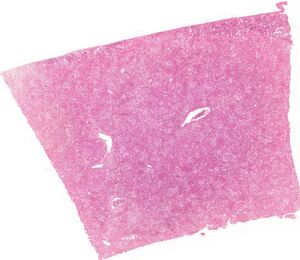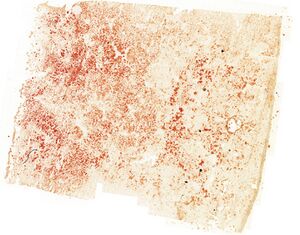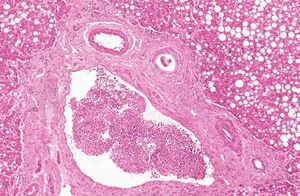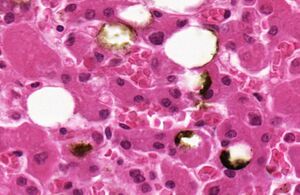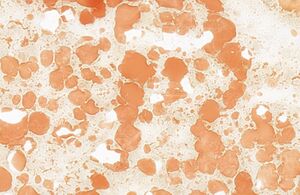8. Steatosis hepatis: Difference between revisions
(Created page with "'''Staining''': HE and oil-red '''Organ''': Liver '''Description''': HE: We can see the portal triad, meaning that we are looking at a liver. There is panlobular fat accumulation (fat is present in the whole lobule) in the whole slide. Oil-red: With this staining the fat is reddish-orangeish. '''Diagnosis''': Hepatic steatosis Causes: * Alcohol consumption * Metabolic syndrome (DM2, obesity) * Medications '''Theory''': When fixating the normal slides, we use for...") |
(No difference)
|
Revision as of 08:51, 9 May 2022
Staining: HE and oil-red
Organ: Liver
Description:
HE: We can see the portal triad, meaning that we are looking at a liver. There is panlobular fat accumulation (fat is present in the whole lobule) in the whole slide.
Oil-red: With this staining the fat is reddish-orangeish.
Diagnosis: Hepatic steatosis
Causes:
- Alcohol consumption
- Metabolic syndrome (DM2, obesity)
- Medications
Theory:
When fixating the normal slides, we use formalin. Formalin dissolves fat, which is why fat isn’t directly seen in the HE slides. In the oil-red slide there was no formalin but instead the slide was frozen. This preserves the fat.
Oil-red can be used to determine the amount of fat and therefore the severity of the steatosis.
In this slide there was panlobular fat, but in some cases there can be pericentral fat, where fat can only be found around the central veins.
The enzyme ADH that metabolizes ethanol depletes NAD+ and increases NADH. NADH stimulates fatty acid synthesis. NAD+ is needed for β-oxidation of the fat. This causes fat to accumulate in the hepatocytes.
